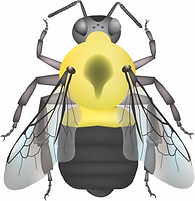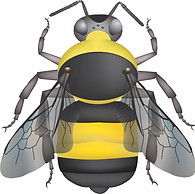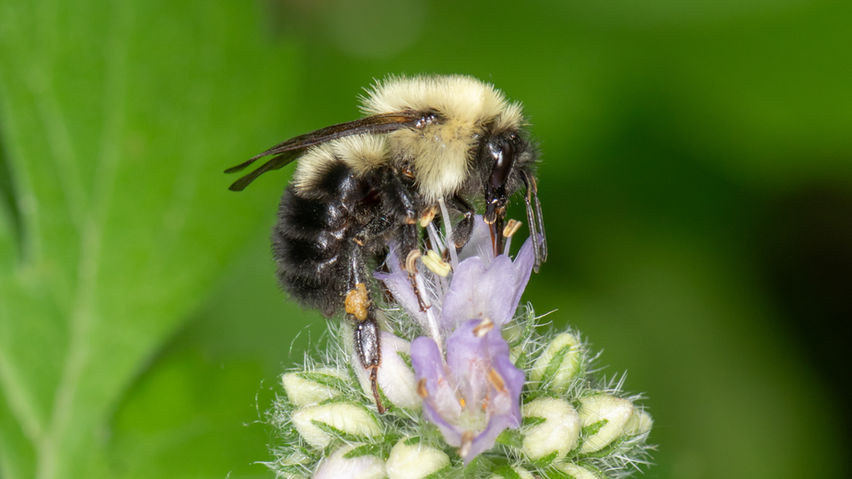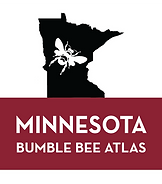Bombus
Bumble Bees
In Minnesota, there are twenty-five described species within the genus Bombus. Six of these species are social parasites that do not establish their own nests but instead take over (usurp) an active nest, then kill, drive out the founding queen, or coexist in the nest with the queen. The remaining nest-establishing species have annual eusocial nests that are founded by a reproductive female (gyne) in spring after she emerges from winter hibernation. Bombus are the most recognizable genus of bees in Minnesota given their large size, fuzzy appearance, season-long activity, and tendency to visit a wide variety of flowering plants.
Bumble bees nest in cavities with preexisting insulation. These cavities can be belowground in abandoned rodent or chipmunk burrows, on the ground under thatch, plant debris, or logs, in cavities in wood on or near the ground, under structures or objects such as sheds, and less often aboveground in bird nest boxes or other locations providing some insulation. Bombus are polylectic; collectively, all castes (queen, workers, males, gynes) visit a wide variety of flowering plants over the entire growing season. At the species level, more nuanced flower preferences may be guided by tongue length, proximity to nesting habitat, and quality of the floral resources such as lipid/protein ratios. Bees in this genus range in length from 7 to 29 mm (0.27 to 1.14 inches).

Bombus auricomus visiting Desmodium canadense

Bombus terricola visiting Pycnanthemum muticum


Wing position on flowers


25
no. species
in MN
size range

Phenology

Genus Characteristics

Corbicula (pollen basket) on hind leg tibia (absent in parasitic species).
female

Three forewing submarginal cells. Jugal lobe absent on hind wing.
1
2
3

Black integument covered with dense yellow and black hairs. Some species with additional orange, rusty-brown, and/or white hairs.
female

female
Long glossa (tongue) (galea shown)

Females with bare clypeus (lacking hairs).
female

Males with black clypeus covered in dense hairs. Some species with enlarged compound eyes.
male
Distribution

Bombus affinis

Bombus ashtoni (bohemicus)

Bombus auricomus



Bombus bimaculatus









Bombus Species in Minnesota
Scientific Name | Host | Sociality | Nest |
|---|---|---|---|
Bombus affinis | eusocial | belowground | |
Bombus ashtoni (B. bohemicus) | Bombus (Gibbs 2023) - SH rank: possibly extirpated from state | parasitic | |
Bombus auricomus | eusocial | aboveground | |
Bombus bimaculatus | eusocial | below- and aboveground | |
Bombus borealis | eusocial | belowground | |
Bombus citrinus | Bombus bimaculatus, B. impatiens, B. vagans (Gibbs 2023) | parasitic | |
Bombus fervidus | eusocial | aboveground | |
Bombus flavidus (B. fernalde) | Bombus | parasitic | |
Bombus fraternus | eusocial | belowground | |
Bombus frigidus | eusocial | ||
Bombus griseocollis | eusocial | below- and aboveground | |
Bombus huntii | eusocial | ||
Bombus impatiens | eusocial | belowground | |
Bombus insularis | Bombus ternarius (Williams et al. 2014) | parasitic | |
Bombus melanopygus | eusocial | ||
Bombus nevadensis | eusocial | ||
Bombus pensylvanicus | eusocial | aboveground | |
Bombus perplexus | eusocial | belowground | |
Bombus rufocinctus | eusocial | aboveground | |
Bombus sandersoni | eusocial | ||
Bombus suckleyi | Bombus - SX rank: presumed extirpated from state | parasitic | |
Bombus ternarius | eusocial | belowground | |
Bombus terricola | eusocial | belowground | |
Bombus vagans | eusocial | below- and aboveground | |
Bombus variabilis | B. pensylvanicus. B. variabilis rank SX: presumed extirpated from state | parasitic |
Source: Minnesota Department of Natural Resources, Minnesota Bee Species List (August 2023).
https://files.dnr.state.mn.us/eco/mcbs/mn-statewide-bee-list.pdf
Bombus Annual Nest Cycle

Gynes emerge from hibernation.
Workers emerge from nest and collect pollen and nectar.
Gynes establish nest and collect pollen and nectar from flowers.
Gynes search for a nest site.
Males begin emerging.
Some males
establish
territories.
New gynes emerge from nest and visit flowers to sequester fat.
New gynes mate
with a male.
New gynes excavate a
shallow hibernation burrow.
NEST ESTABLISHED
NEST ENDS
Males, workers, and queen perish.
Explore More Apidae Genera
Explore Bee Families

Apidae
15 genera, 133 species
Bumble bees Bombus
Longhorn bees
Epimelissodes, Eucera, Melissodes
Carpenter bees
Ceratina, Xylocopa
Honey bees Apis
Digger bees Anthophora
Cuckoo bees Brachymelecta, Epeolus, Holcopasites, Nomada, Neolarra, Triepeolus
Squash bees Xenoglossa
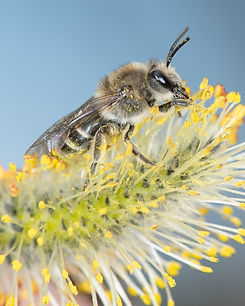
2 genera, 39 species
Halictidae
10 genera, 133 species
Metallic green sweat bees
Agapostemon, Augochlora, Augochlorella, Augochloropsis
Large sweat bees
Dieunomia, Nomia
Short-faced bees Dufourea
Sweat bees Halictus
Small sweat bees Lasioglossum
Cuckoo (blood) bees Sphecodes
Megachilidae
14 genera, 86 species
Resin and pebble bees Anthidiellum, Dianthidium, Heriades, Paranthidium
Carder bees Anthidium, Pseudoanthidium
Mock orange bees Chelostoma
Mason bees Osmia, Hoplitis
Leafcutter bees Megachile
Sharp-tailed cuckoo bees Coelioxys
Dark cuckoo bees Stelis

Citations and Further Reading
Droege, S., Shumar, S., & Maffei, C. (2024). The Very Handy Bee Manual (2.0). Zenodo. https://doi.org/10.5281/zenodo.12812755
Gibbs, J., Hanuschuk, E., Miller, R., Dubois, M., Martini, M., Robinson, S., ... & Onuferko, T. M. (2023). A checklist of the bees (Hymenoptera: Apoidea) of Manitoba, Canada. The Canadian Entomologist, 155, e3.
Mitchell, T. B. (1960). Bees of the eastern United States. Technical Bulletin No. 141. North Carolina Agricultural Experiment Station.
Portman, Z. M., Gardner, J., Lane, I. G., Gerjets, N., Petersen, J. D., Ascher, J. S., ... & Cariveau, D. P. (2023). A checklist of the bees (Hymenoptera: Apoidea) of Minnesota. Zootaxa, 5304(1), 1-95.
Williams, P. H., Thorp, R. W., Richardson, L. L., & Colla, S. R. (2014). Bumble bees of North America: an identification guide. Princeton University Press
Wilson, J. S., & Messinger Carril, O. J. (2016). The bees in your backyard: a guide to North America's bees. Princeton University Press.
Page Photography Credits
Heather Holm
Steve Mlodinow CC BY-NC 4.0 (Brachymelecta)
Michelle Orcutt CC-BY-NC 4.0 (Epimelissodes female)
Page Illustration Credits
Elaine Evans, Xerces Society - bumble bee illustrations


